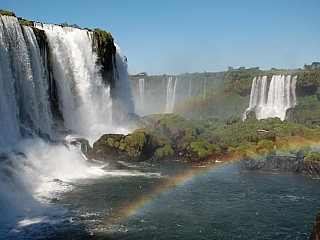Words and photos are not enough to describe Iguassu Falls. The Iguassu Falls in Iguassu National Park, is a natural beauty that must be heard and admired with your own eyes. Foz do Iguassu is an important site for eco-tourism, making it one of the most desirable destinations for people from all over the world.
Altogether there are 275 waterfalls along the border with Paraguay and Argentina. More than 3 km wide and 80 feet tall, this makes them wider than Victoria, higher than Niagara and more beautiful than any of the other famous waterfalls in the world.
Located on the Parana River, Itaipu is the largest dam in the world and supplies around 80% of the energy consumed by Paraguay and 25% for the energy consumed in Brazil. The plant has an installed capacity of 12,600 megawatts (MW), with 18 generating units capable of producing 700 MW each.
You can also visit the bird park which is set in 5 acres of subtropical native forest. It offers tourists, ecologists, photographers and birdwatchers an opportunity to enter the huge aviaries to study and photograph birds in their natural habitat without the restriction of netting and cages.
In addition to more than 800 birds, both endemic and from other continents you will find other animals, such as caimans, snakes, spiders and butterflies.
Here are some facts about the Iguassu Falls:
- The word Iguassu means "big water" in Tupi-Guarani.
- The falls are formed by the Iguassu River. Eighteen miles before joining the River Paraná, the Iguassu won a sloping ground and rushes when dropped up to 80 meters high, reaching a width of 2780 meters.
- Its geological formation dating from about 150 million years, but the formation of the landform of the falls began approximately 200,000 years.
- The Iguassu River spans 1200 meters wide above the falls. Below, in a narrow channel to 65. The total width of the Falls in Brazil is approximately 800m and 1900m on the Argentine side. The height of fall is about 40 to 80 meters. Depending on the river flow, the number of hops varies, reaching a number greater than 100 during periods of average flow.
- The average flow of the river is around 1,500 m3 per second, ranging from 500 m3 / s in times of drought to 8.500 m3 / s in the rainy season.
- The greater volume of water occurs between the months of October to March.
- There are 19 important waterfalls, five of them from the Brazilian side (Floriano, Deodoro and Benjamin Constant, Santa Maria and Union) and the other on the Argentine side. The arrangement of jumps, with most of them on the Argentine side and facing Brazil, provides the best view for those who observe the scenery from Brazil.
















